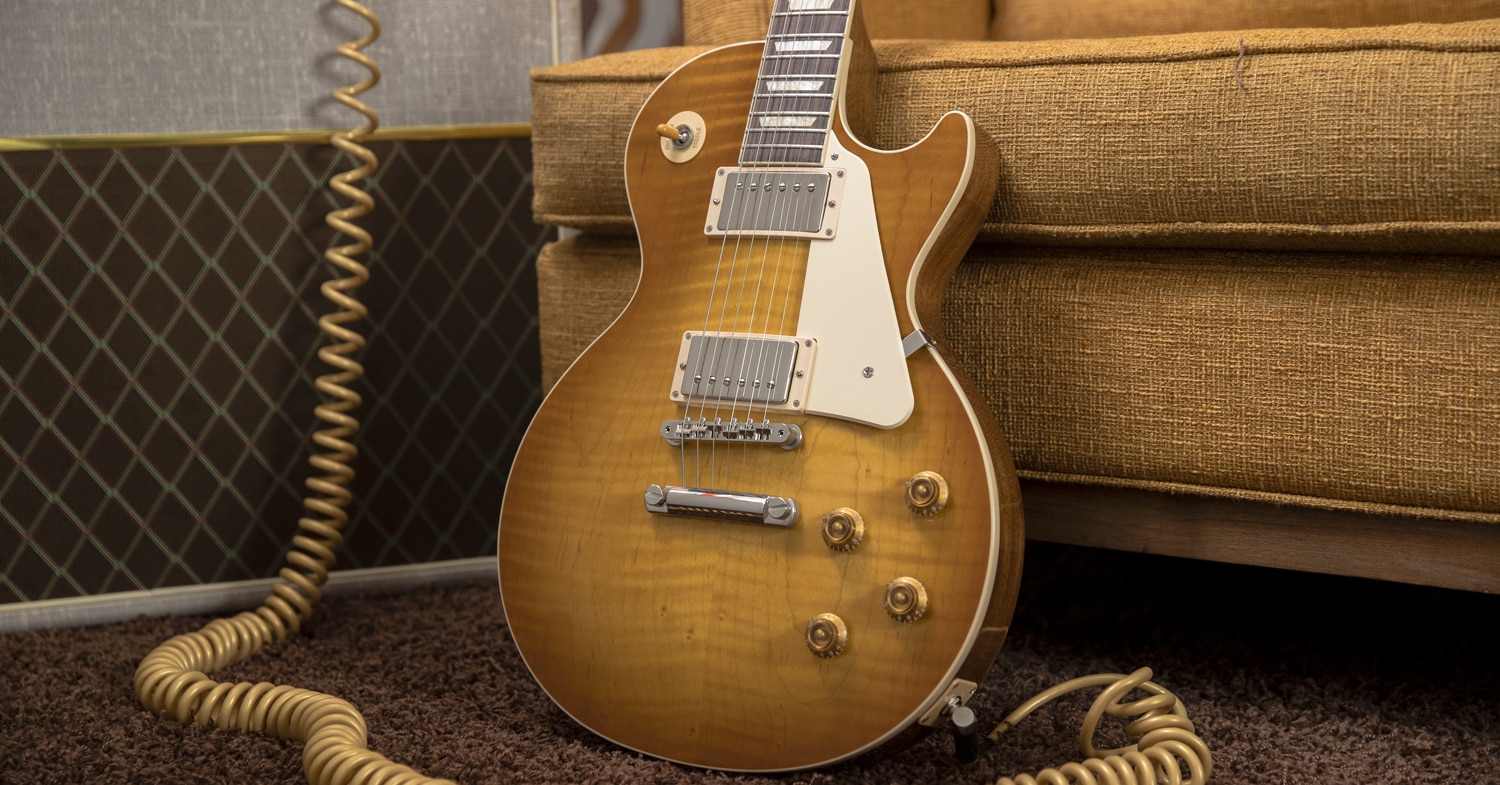Knowing how to choose a Les Paul electric guitar, whether Gibson or Epiphone, can be a challenge. Making sense of all of the different models, features and specifications requires a lot of research and time. Thankfully, the experts here at Musician's Friend are here to help you choose the best Les Paul for your needs and budget.
Table of Contents
The Les Paul Legacy — A Brief History
Epiphone Les Paul Series
Gibson USA Les Paul Series
Gibson Custom Shop Les Paul Models
Why Buy Your Les Paul from Musician's Friend?
Need More Help?
About Our Private Reserve Collection
Glossary of Les Paul Terms
The Les Paul Legacy—A Brief History
The guitar that bears Les Paul’s name is among the most iconic instruments that have helped shape the sound of popular music. Since its introduction in 1952, the LP’s rich, thick, midrange-focused tone, coupled with a prodigious ability to sustain notes has had a huge impact on the sound of rock, blues, metal, and those genres' modern offshoots.
Though there’s some controversy about exactly who contributed what elements, it’s clear that the LP was the result of a fateful collaboration between Gibson president Ted McCarty and Les Paul, the brilliant country and jazz guitarist and compulsive inventor and tinkerer. The trajectory of Gibson’s product line and Paul’s search for an electric guitar with more sustain and less feedback made that collaboration more or less inevitable.
First Came The Clunker
Les Paul had struggled for years with the feedback generated by electric hollowbody guitars when their volume was cranked up. In the early 1940s he bought an Epiphone Broadway hollowbody and retrofitted it with his own hand-wound pickups and a rectangular steel bar body brace. Though “The Clunker,” as Paul nicknamed it, partially overcame feedback, it wasn’t until he began experimenting with solidbody designs that feedback was fully tamed.
Then Came The Log
His solidbody prototype called “The Log” had a body made from a solid chunk of pine that was just a bit wider than the neck and fretboard, and a little deeper than a standard hollowbody guitar. Paul attached two wooden wings on either side of the slab giving The Log roughly the appearance of a conventional archtop guitar. Unlovely to look at, it delivered on Paul’s aim to get feedback under control. Around 1946, he took his design to Gibson, but the company didn’t bite.
And Finally, the Les Paul was Born
It took several years and the introduction of a highly successful solidbody electric guitar by a certain California guitar company to bring Gibson around. The result was the Les Paul introduced in 1952. Unlike the upstart from the West Coast with it’s its flashy, modernistic styling, slab body, bolt-on neck, and twangy tone, Gibson focused on building a solidbody instrument that retained the look of its carved-top hollowbody guitars, sharing their set-neck construction and trapeze tailpiece.
The Les Paul would eventually be offered in four models during the ‘50s and early ‘60s—the Custom, Standard, Special, and Junior. The LP took the guitar world by storm. Its solid mahogany body with a thin maple cap solved the age-old problem of feedback while producing remarkable sustain, and it’s ornate Florentine cutaway facilitated high-note soloing. Initially equipped with dual P-90 single-coil pickups, the introduction of Gibson’s PAF (Patent Applied For) humbucking pickup eliminated the hum that plagued electric guitars with single-coil pickups while delivering the fat, thick tone that has become a sonic hallmark of the Les Paul.
In 1957 the Les Paul Custom came to market with its dual PAFs. A three-pickup version followed. Beginning in the early 1970s, Gibson has released dozens of variations of the LP, and the guitar has only grown in stature. Oddly though, in the early 1960s the Les Paul fell out of favor due to issues of weight and cost as well as a perception that it was a bit old-fashioned. But starting in the mid-’60s, British artists such as Keith Richards, Eric Clapton, Peter Green, and Jimmy Page, who all loved its thick, rock- and blues-friendly tone, rekindled interest in the LP. This resulted in the 1968 resumption of LP production.
Everybody Loves the LP
The list of artists who have wielded Les Pauls is legion. As noted above, it was British blues rockers like Clapton who led the way to the LP’s resurgence. They had been listening to LP-brandishing guitarists such as Texas bluesman Freddie King and his rollicking instrumental “Hideaway,” and to Howlin’ Wolf axman Hubert Sumlin’s stinging riffs on “Smokestack Lightning.” And they wanted some of that sound too!
On this side of the Atlantic it was Michael Bloomfield who helped cement the LP’s position as the go-to electric among heavy rock and blues players. The phenomenally talented Chicago native first owned a 1954 Les Paul goldtop, later trading up for the ‘59 LP Standard with which he’s most closely associated. The fat yet clean sound of Bloomfield’s LP was an urgent driving force in the Paul Butterfield Blues Band—for a time Dylan’s electric backup band that caused a ruckus at the Newport Folk Festival. In 2009 Gibson’s Custom Shop, recognizing Bloomfield’s contribution to LP lore, produced a painstaking limited-edition reproduction of his axe, replete with battle scars and Bloomfield’s mods.
A list of the other signature and tribute Les Pauls that Gibson has built invoke some of the most stellar names in modern music. They include Jimmy Page, Slash, Joe Perry, Ace Frehley, Marc Bolan, Jeff Beck, Pete Townshend, Billie Joe Armstrong, and dozens more. As we explore the many Les Paul models available today, we’ll touch on some of these special editions.
Epiphone Les Paul Series
The connection between inventor-musician Les Paul and Epiphone dates back to the late 1930s. In fact, Paul’s “The Log” was built during after-hours tinkering sessions in Epiphone’s New York plant, and the musician was a frequent consultant on designs, offering the insights of both a seasoned performer and audio innovator.
In 1957 Gibson acquired Epiphone, a long-standing rival in the market for hollowbody electric guitars. After the buyout, Epiphone instruments were built in Gibson’s factories and shared many of the same woods and components used in Gibson’s product line. Many Epiphone guitars were essentially identical to their Gibson counterparts.
Beginning in the 1970s, most Epiphone instruments were built in Japan and later in Korea. Continuing today, Epiphone guitars are built in Asian plants to Gibson’s exacting specifications. Having less hand work and less costly woods, hardware, and finishes than their U.S.-made counterparts, Epiphone versions of Gibson models offer excellent value for budget-conscious guitarists.
Epiphone's recent overhaul of their Les Paul line-up includes some significant changes, with the core line-up of models mirroring Gibson's core offerings. One particularly notable change is the return to the Kalamazoo headstock, first seen in 1930.
Let’s look at the lineup of Epiphone Les Paul series and models:
Epiphone Les Paul Standard
The Epiphone Les Paul Standard series extends the LP legacy with a number of models loaded with essential Paul features, designed to capture the sound and feel of the Golden Era of Les Pauls. Models include the Les Paul Standard '50s, Les Paul Standard '60s, and a limited edition Les Paul Standard '60s Quilt Top model.
There’s also a 1959 Les Paul Standard Outfit model. Loaded with Gibson Burstbucker pickups, this model offers incredible PAF-inspired tone, fantastic playability and high-end appointments not typically associated with an import model.
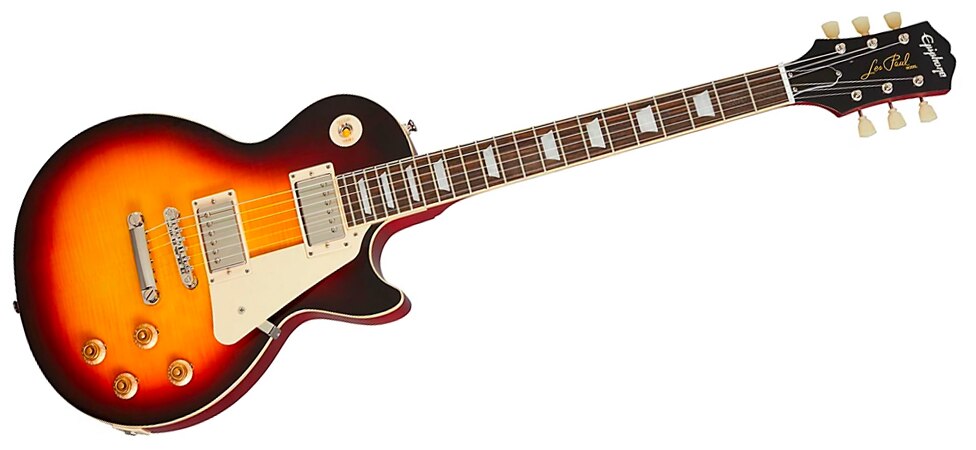
The Epiphone 1959 Les Paul Standard Outfit delivers classic, thick PAF-inspired tone thanks to its Gibson USA Burstbuckers pickups.
Epiphone Les Paul Custom
Inspired by the Gibson Les Paul Custom, first released in 1954, this Epi LP Custom is replete with flashy appointments like gold hardware and custom inlays. But it's not all about looks here as this Les Paul Custom features a pair of ProBucker pickups, a comfortable Slim Taper mahogany neck and a 22-fret ebony fingerboard for a premium playing experience.
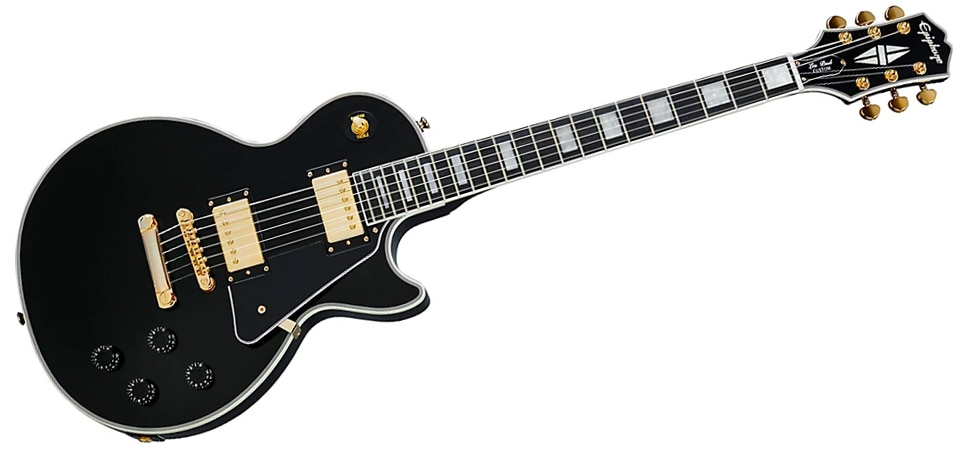
The Epiphone Les Paul Custom is the perfect choice for the guitarist that wants to stand out sonically and visually.
Epiphone Les Paul Junior
When Gibson first introduced the Les Paul Junior in 1954, it was designed to offer an affordable entry point for players looking to get into the LP world. Like the original that inspired it, the Epiphone Les Paul Junior keeps it simple: classic single cutaway body and a solitary Dog Ear Pro P-90 single-coil pickup. While some guitarists may bristle at such a limitation, rest assured, this instrument has plenty of great tone on tap.
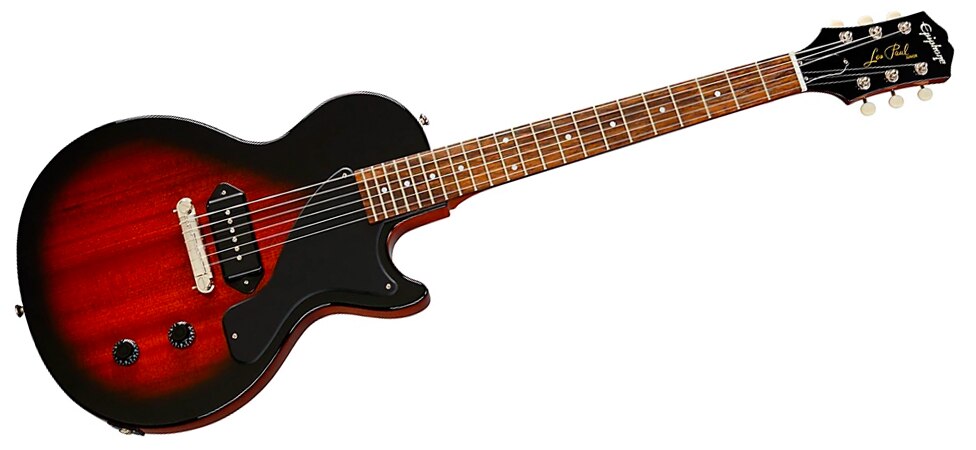
Classic single-coil P-90 tone in an affordable package? That'd be the Epiphone Les Paul Junior.
Epiphone Les Paul Special
Originally introduced in 1955, the Les Paul Special was viewed as a logical uppgrade to the single-coil Les Paul Junior released the prior year. The Epiphone Les Paul Special features dual single-coil Pro P90 pickups, slab mahogany construction and a thick '50s-style mahogany neck with a 12" radius Indian Laurel fretboard. The TV Yellow finish, Deluxe Vintage Ivory tuners and Lightning Bar wraparound bridge offer classic aesthetics while the updated '60s Kalamazoo headstock nods to the LP's Gibson roots.
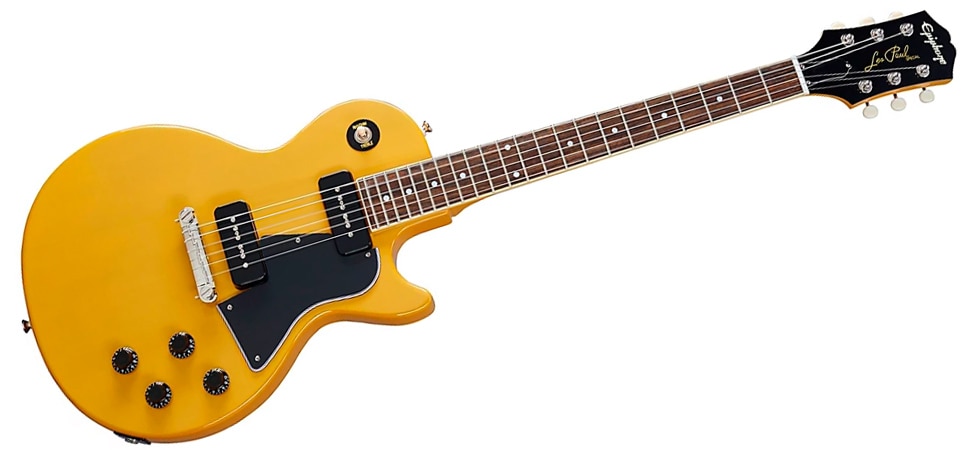
The Epiphone Les Paul Special delivers classic no-nonsense P-90 tones in a vintage-inspired TV Yellow finish.
Epiphone Les Paul Classic
While it's looks may recall a late-50s Gibson Les Paul, the Epiphone Les Paul Classic has a series of modern, player-friendly tricks up its sleeve. Loaded with dual uncovered Alnico Classic PRO zebra humbuckers, the LP Classic is wired up for coil-splitting and phase switching, serving up plenty of tonal options for your next gig or recording session.
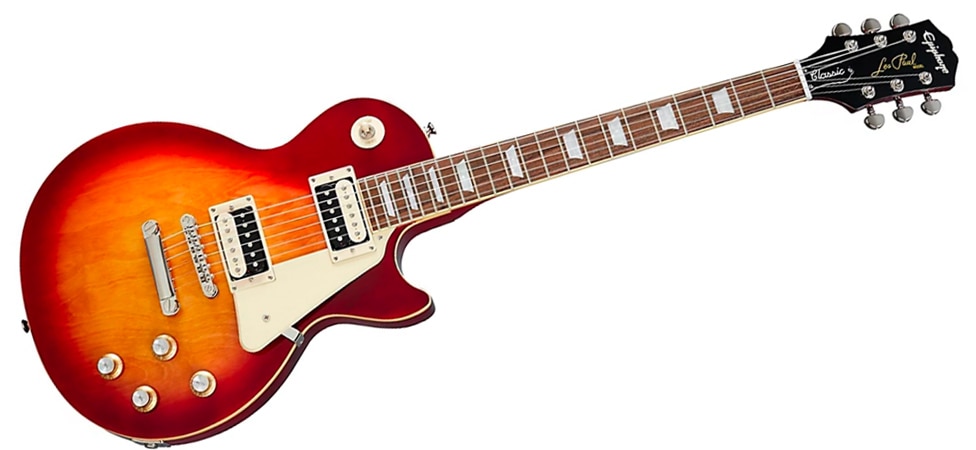
The Epiphone Les Paul Classic offers classic look with modern, player-friendly features like advanced wiring, modern 18:1 Grover Rotomatic tuners and more.
Epiphone Les Paul Studio
If you're after a no-frills tone machine, the Epiphone Les Paul Studio just may be the perfect choice for you. Outfitted with two Alnico Classic PRO humbuckers wired for push-pull coil-splitting, the budget-friendly LP Studio offers guitarists a wide range of sounds to play with, from the chimiest cleans to the heaviest rhythm and lead tones.
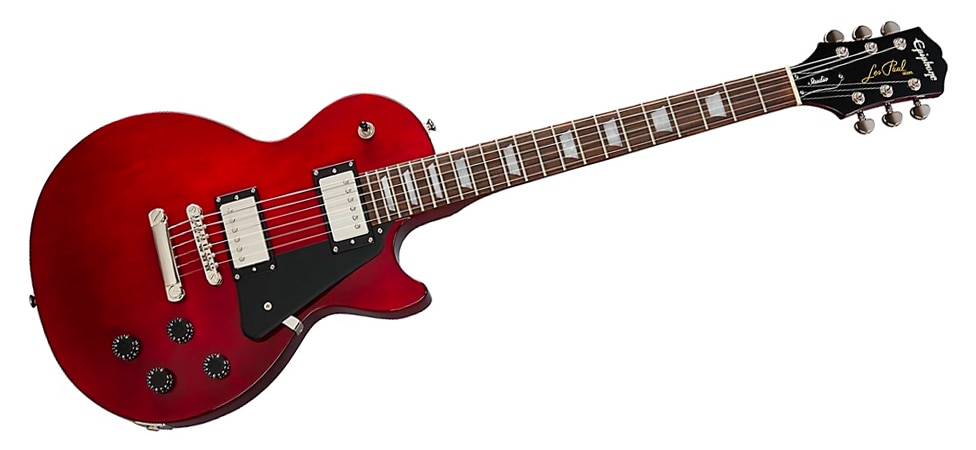
The Epiphone Les Paul Studio offers classic Les Paul tone with a stripped-down look.
Epiphone Les Paul Modern
Epiphone's Les Paul Modern gives you everything you love about the iconic instrument with player-friendly updates like a weight-relieved mahogany body, an assymetrical neck taper with contoured heel for easy upper-fret access and a 12" radius ebony fingerboard for effortless string bending. The LP Modern's dual ProBuckers deliver PAF-like tones, while its advanced wiring lets you split each pickup for single-coil sounds or flip the phase for a Peter Green-inspired sound.
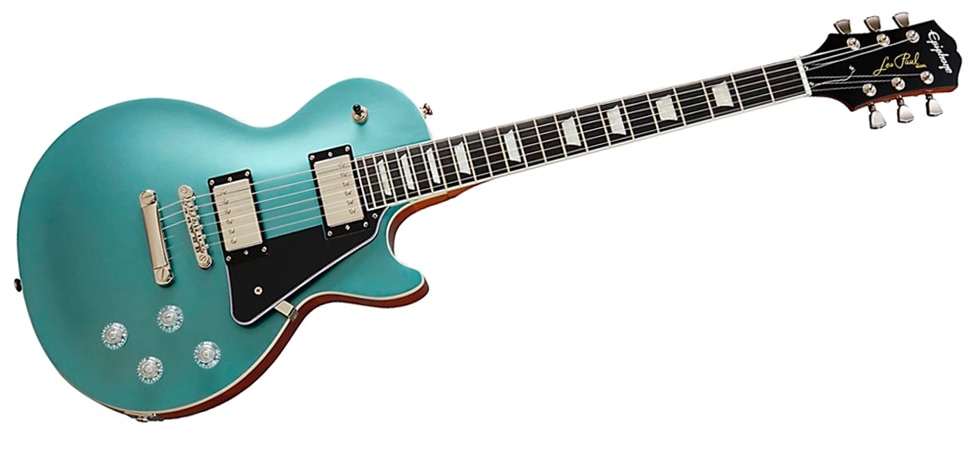
The Epiphone Les Paul Modern is truly a player's LP, thanks to its weight-relieved body, assymetrical mahogany neck with contoured heel and advanced electronics.
Epiphone Les Paul Prophecy
Similar to the Les Paul Modern, Epiphone's Les Paul Prophecy pushes the classic formula forward with a range of modern, player-friendly features in a striking package. Its AAA flame maple veneer top is finished in aged vintage gloss, capping off its weight-relieved mahogany body. A pair of Fishman Fluence pickups offer three unique tones: PAF-inspired, hot active humbuckers and slightly over-wound single coils, all accesible via push/pull volume and tone pots. Even better, they're completely noise-free.
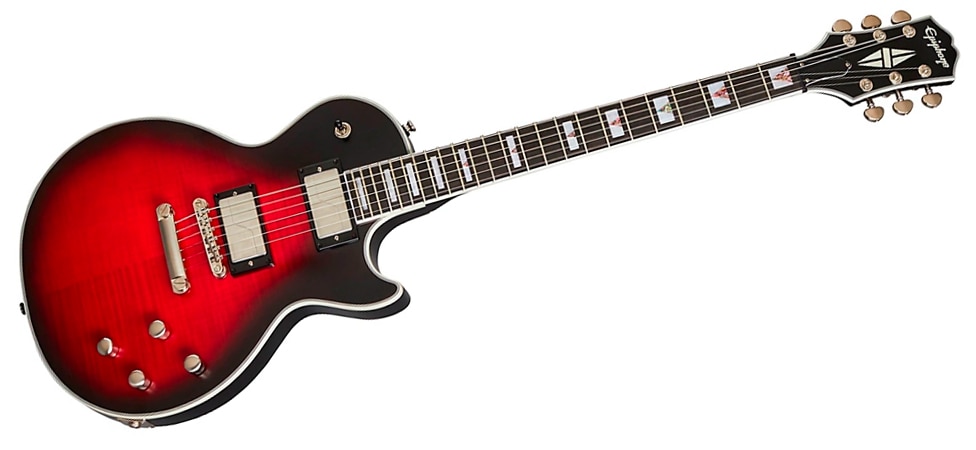
The Epiphone Les Paul Prophecy offers stunning looks, versatile Fishman Fluence pickups and stunning fretboard inlays.
Epiphone Les Paul Melody Maker E1
Aimed squarely at new guitarists who have more enthusiasm than budget, the Les Paul Melody Maker E1 is the least costly LP made by Epiphone. Its thinner poplar body and SlimTaper boilt-on neck are easier for younger, smaller players to handle. A pair of ceramic single-coil pickups churn out authentic rock’n’ roll snarl. The ‘60s-era truss rod cover and headstock logo evoke vintage Les Pauls while the palette of available finish colors range from classic to contemporary.
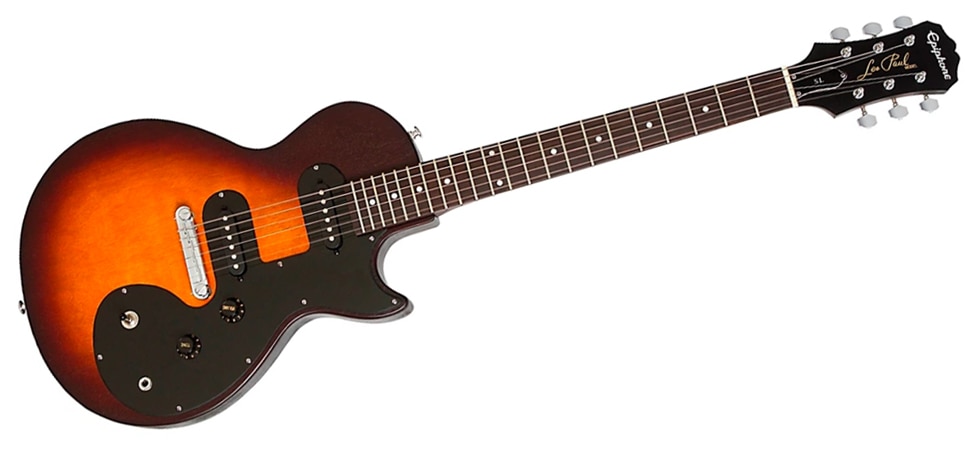
The super-affordable Epiphone Les Paul Melody Maker E1 Electric Guitar makes a great first guitar.
Epiphone Les Paul Performance Packs
Epiphone has the new guitarist in mind with its Les Paul Performance Packs. They come complete with everything you need to start jamming right out of the box, and are an awesome value. Take the Epiphone Slash “AFD” Les Paul Guitar Outfit. You get a dual-humbucker LP Special-II Guitar, a sweet little 2-channel 15-watt Slash Snakepit amp, plus all the extras like a gig bag, strap, cable, picks and access to online eMedia guitar lessons.

With the Slash “AFD” Les Paul Guitar Outfit you get the works—everything needed to start learning guitar.
Gibson USA Les Pauls
Built in their Nashville facility, Gibson's Les Pauls continue to maintain their flagship status well into their sixth decade of production. The meticulous attention to detail, premium-quality woods, electronics, hardware, lavish finishes, and extensive handwork that made the LP an icon of American craftsmanship persist to this day.
Gibson Les Paul Standard '50s P-90
Paying tribute to the iconic Goldtop first introduced in 1952, the Les Paul Standard '50s P-90 is resplendent in its eyecathching finish. A pair of single-coil P-90s deliver punch and clarity, while the classic maple top/mahogany body combo overflows with harmonic-rich sustain. Its bound mahogany neck has a period-correct '50s Vintage shape, while the Vintage Deluxe keystone tuners deliver the look and performance you'd expect.
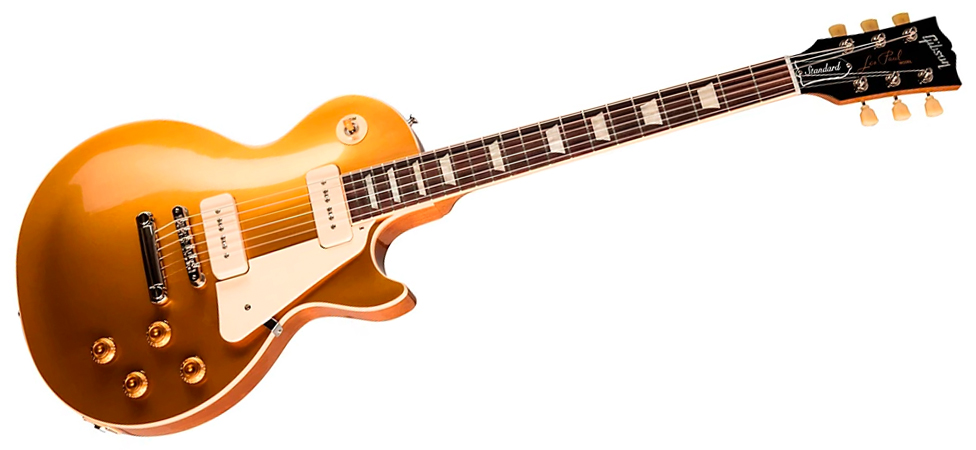
The Gibson Les Paul Standard '50s P-90 pays tribute to the iconic Goldtop that made its debut in 1952.
Gibson Les Paul Stadard '50s
Nearly identical in spec to its P-90 sibling, the Gibson Les Paul Standard '50s swaps in a figured maple top and a pair of Alnico II BurstBucker pickups for a distinctly PAF-flavored sound. Available in three striking finishes, the LP Standard '50s is a joy to play and absolutely oozes tone.
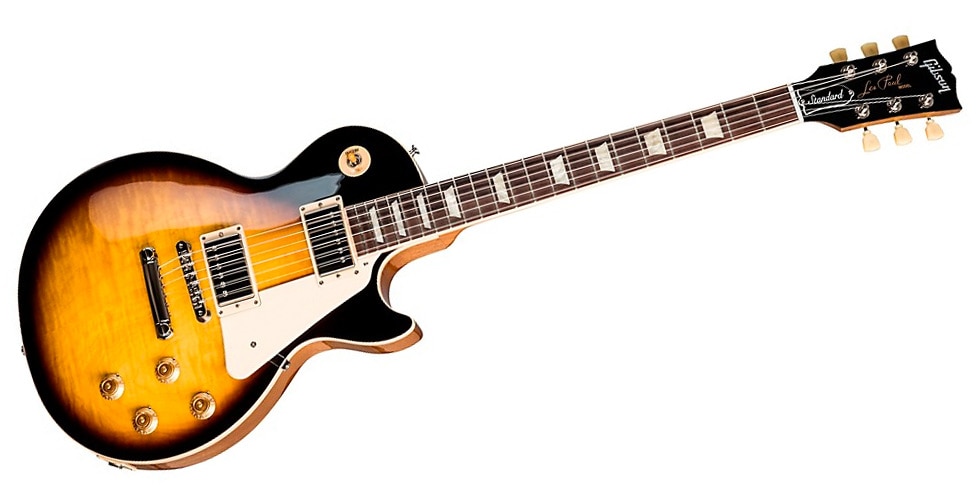
The Les Paul Standard '50s features a beautiful figured maple top and a pair of PAF-inspired Alnico II BurstBucker pickups.
Gibson Les Paul Standard '60s
Inspired by the instruments wielded by some of the most iconic LP players of all time, the Les Paul Standard ’60s features a beautiful AA figured maple top, a pair of BurstBucker '61 pickups and a comfortable ’60s SlimTaper neck shape. Compared to the BurstBuckers found on the '50s models, the '61 models offer are a bit hotter, with a touch more top end.
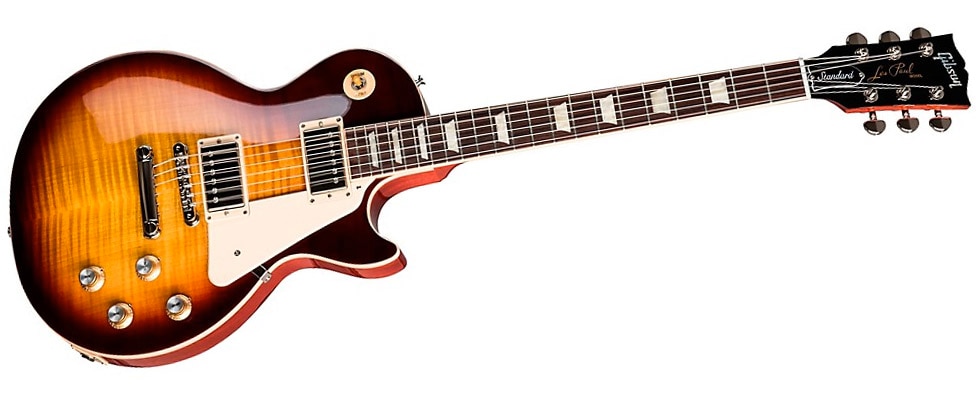
The Gibson Les Paul Standard '60s is loaded with a pair of BurstBucker '61 pickups offering more output than the pickups found in the LP Standard '50s model.
Gibson Les Paul Junior
Originally introduced in 1954, the budget-friendly, begginer-minded Gibson Les Paul Junior is as straightforward as it comes: a slab mahogany body, a single dog-ear P-90 pickup and two controls. Sure, it may not offer the versatility of other LPs, but sometimes simpler is better.
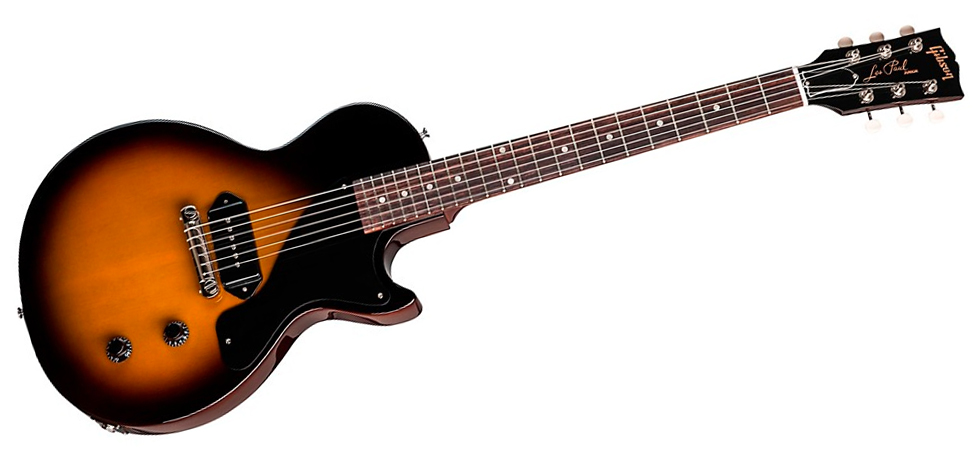
The slab body Gibson Les Paul Junior is a single-pickup powerhouse.
Gibson Les Paul Special
Borne of the Les Paul Junior, the stripped-down Les Paul Special was originally introduced as a budget-friendly model, adding a second P-90 single-coil pickup to its slab mahogany body. Available in TV Yellow or Cherry Red, this nitro-finished, no-frills model is an absolute tone machine.
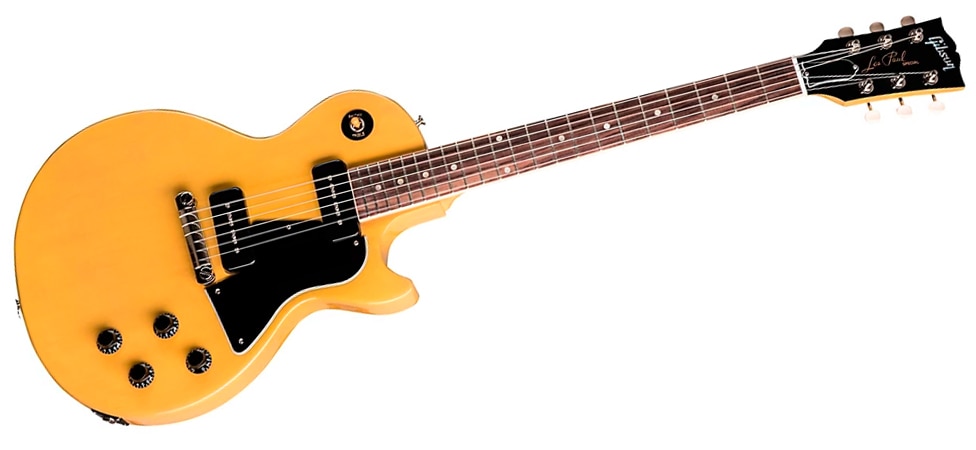
The Gibson Les Paul Special's dual P-90s deliver just the right amount of crunch, making it a go-to instrument for punk rock guitarists.
Gibson Les Paul Deluxe '70s
If you're looking for a slightly different sound, you may want to take a closer look at the Les Paul Deluxe '70s. Loaded with a pair of mini humbuckers, the LP Deluxe '70s' sound is a touch brighter than you'll encounter with PAF-powered models, owing to the smaller bobbins of the pickups, which allow for fewer windings.
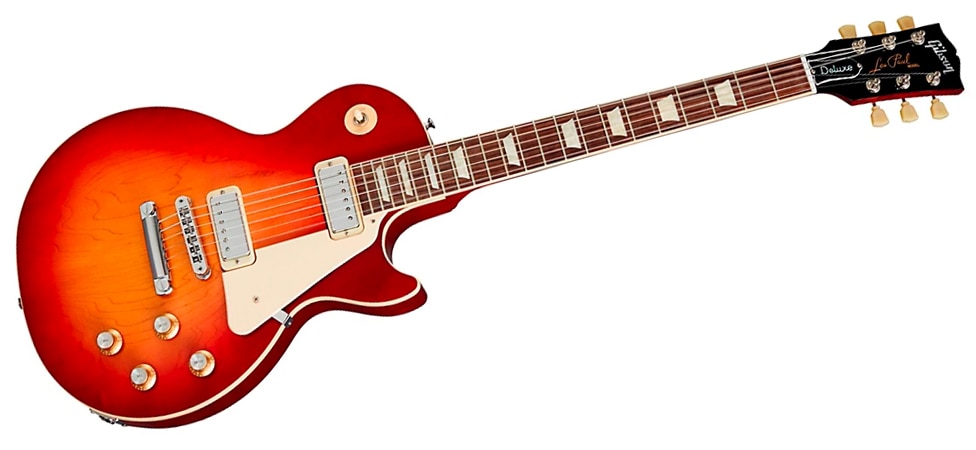
If you've never played a guitar loaded with mini humbuckers, the Gibson Les Paul Deluxe '70s is a great place to start.
Gibson Les Paul Studio
While the Les Paul Junior and Les Paul Special were squarely aimed at beginners when initially introduced, the Les Paul Studio, which debuted in 1983, was originally designed for players who wanted all the tone without all of the upscale cosmetics found on the higher-priced models. The current LP Studio continues that heritage. Its weight-relived mahogany body delivers tight, high-output sound thanks to its 490R and 498T humbucking pickups.
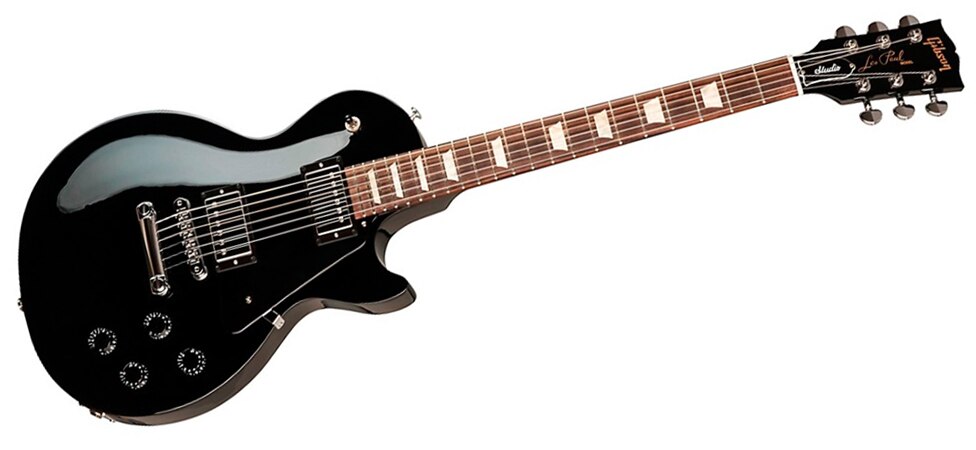
Loaded with tone, the no-frills, weight-relieved Gibson Les Paul Studio has plenty of output courtesy of its 490R and 498T humbuckers.
Gibson Les Paul Classic
Although its looks may recall early '60s models, the Gibson Les Paul Classic is an exceptionally modern instrument. Its 9-hole weight-relieved body offers long-playing comfort while its uncovered BurstBucker 61R and 61T pickups are wired to four push-pull pots, offering up coil tapping, phase switching and pure bypass for a range of tonal options.
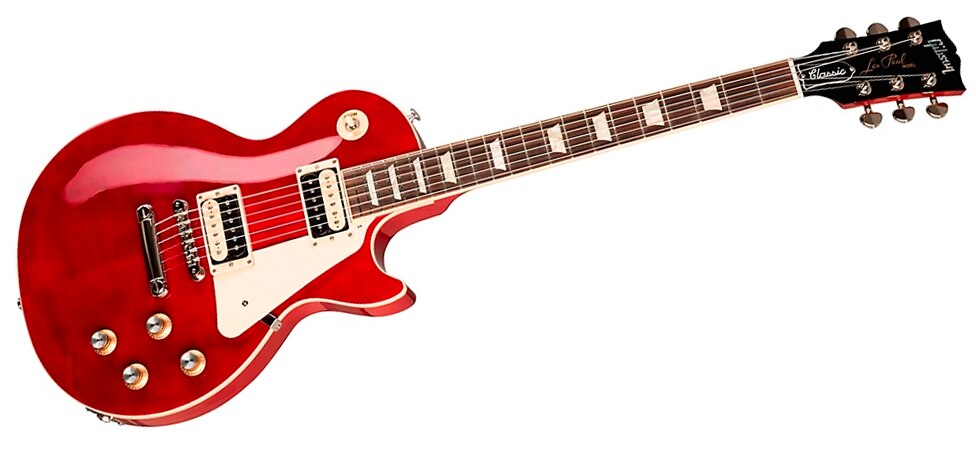
Underneath its iconic looks Gibson's Les Paul Classic is wired for versatility, with coil tapping, phase switching and pure bypass.
Gibson Les Paul Modern
While the Les Paul Classic blends modern versatiity with tried-and-true looks, the Gibson Les Paul Modern takes it even further. There's plenty of tonal choices to pick from thanks to the BurstBucker Pro and Pro+ pickups, which are wired up to push/pull pots for coil tapping, phase switching and pure bypass. Its assymetrical SlimTaper neck, compound radius fretboard and contoured heel offer the type of performance modern players crave.
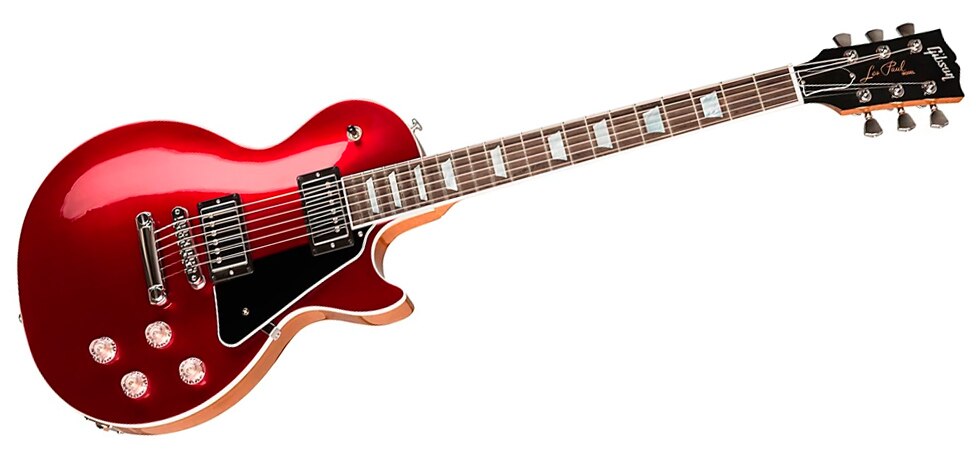
The Gibson Les Paul Modern is built for forward-thinking guitarists who want the classic LP platform with forward-looking specs.
Gibson Custom Shop
If you're looking for some of the finest Les Pauls ever built, check out our incredible selection from the Gibson Custom Shop. Built by the most skilled builders in Gibson's Nashville factory, each guitar that leaves the building reflects their unerring commitment to quality, craftwork and sound. Whether you want a vintage accurate reissue or a limited-run model that takes the iconic instrument to all new places, the Gibson Custom Shop is where you want to be.
Murphy Lab
In March of 2021, the Murphy Lab was launched within the Gibson Custom Shop. For more than two decades industry pioneer Tom Murphy has mastered the science (and art) of guitar aging. Working with his team of artisans, each of whom have been trained by Tom himself, the Murphy Lab applies a range of aging options to Les Pauls, from Ultra Light to Ultra Heavy, to Gibson's Custom Shop instruments, resulting in Les Pauls that offer the look and feel of vintage instruments.
Why Buy Your Les Paul From Musician's Friend?
We want you to be pleased with your Les Paul purchase, and offer a generous return policy so you can order your new guitar with total confidence.
Need More Help?
After reading this guide, if you’re still not sure which Gibson or Epiphone LP is right for you, we invite you to call one of our friendly and knowledgeable Gear Advisers who will help you find the perfect Les Paul.
About Our Private Reserve Collection
Gibson Custom Les Paul models are offered through our Private Reserve Guitars collection, staffed by a team of highly experienced guitar specialists. Our team offers up personal consultations, in-hand description of specific models and detailed photos for any instruments you’d like to explore further.
Glossary of Les Paul Terms
’60s neck: the flatter, slimmer neck profile introduced found on ‘60s- era Les Pauls and most SG models. Also called the slim-taper neck.
490R: neck (or R for rhythm) pickup from Gibson’s lineup of Modern pickups that use Alnico 2 magnets providing traditional humbucker tone with enhanced highs. Usually paired with a 490T bridge pickup.
490T: bridge position (or T for treble) pickup from Gibson’s lineup of Modern pickups that use Alnico 2 magnets providing traditional humbucker tone with enhanced highs. Usually paired with a 490R pickup.
496R: from Gibson’s lineup of Modern pickups, it features a ceramic magnet for hotter output. The 496R is used in the neck position. The R stands for “Rhythm”—which is how the neck position is usually labeled on the pickup selector switch on an LP. The 496R is usually paired with the 500T pickup used in the bridge position (“T” for “Treble” pickup switch setting).
498T: bridge position pickup from Gibson’s Modern line of pickups that uses ceramic ringed magnets for higher output, enhanced mids, and more highs (and less bottom than the alnico magnet BurstBucker).
500T: Gibson bridge position pickup from its Modern line uses ceramic ringed magnets for higher output and more highs, increased sustain and definition (and less bottom than the alnico magnet BurstBucker). Usually paired with 496R neck position pickup.
’57 Classic: from Gibson’s line of Historic Humbuckers. Uses Alnico 2 magnet material and balanced coil windings to produce vintage sound with rich, warmer tones.
’57 Classic Plus: from Gibson’s line of Historic Humbuckers. Uses Alnico 2 magnet material and slightly overwound coils for increased output.
A maple: single A rating for maple means the wood is perfectly clear with no mineral streaks or other defects. Has little or no figuring or “flame.”
AA maple: predominantly figured, or what many call “flamed”—contains a fair amount of figuring (more than half).
AAA maple: significantly figured or flamed
AAAA maple: very heavily figured or flamed
ABR-1 bridge: same as Tune-O-Matic bridge. This was the part designation of Gibson’s first fully adjustable bridge. Used in conjunction with a separate stop tailpiece. See Tune-O-Matic.
Abalone: an ear-shaped shell lined with mother-of-pearl found in a sea mollusk—used for guitar inlays.
Aged plastic parts: treated to make them look as if they have seen extensive use. For example, numbers on knobs may be discolored and faded.
Alnico magnet: made with an alloy of aluminum, nickel, and cobalt, from which its name is derived. Used for magnets in pickups. Alnico 2 produces a sweet, traditional humbucker tone, while Alnico 5 (also designated Alnico V) is a little stronger, and produces a brighter, hotter tone.
Appointments: the visual aspects of a guitar’s body, neck, and headstock that enhance the guitar’s look and value. Appointments include binding, inlays, and hardware.
Auto trim tuners: Tuning machines with built-in cutters that trim excess string left hanging out of the tuning post.
Beveled: square edges on a guitar body, pickup or other surface that have been reduced to sloping edges. Bevels help the guitar to nestle more comfortably against the guitarist’s rib cage.
Bigsby vibrato: a tailpiece with a bar that lets guitarists raise or lower the tension—and the pitch—of the strings. Also called “tremolo bar” or “whammy bar.”
Binding: decorative appointment that covers the join of the body and the top or the join of the fretboard and the neck. Also used to cover the join of the fretboard to the neck. Ply refers to the number of layers in the binding, e.g. 3-ply or 7-ply.
Bolt-on neck: a neck that is attached into a fitted slot in the body by means of three or four wood screws running through the back of the body and into the back of the neck. This method of attaching necks was critical in the development of the electric guitar because it reduced production costs, making electric guitars more affordable. A bolt-on neck can be replaced, adjusted, or repaired with far less skilled labor than is required for other neck types. Bolt-on necks are used on some low-cost Epiphone Les Paul models.
Burst: abbreviation of the word sunburst. See Sunburst finish.
BurstBucker: the name for Gibson pickups from its Historic Humbucker lineup.
BurstBucker Type 1, Type 2, and Type 3 feature Alnico 2 magnets and are replicas of “Patent Applied For” humbucker pickups found on early Les Pauls. All three types feature an airy tone. Type 1 pickups have unbalanced coils that are slightly underwound. Type 2 has coils that are wound to specification. Type 3 has unbalanced coils that are slightly overwound.
BurstBucker Pro: pickups feature Alnico 5 magnets and wax potting and have an enhanced “Patent Applied For” tone with more bite and brilliance.
Carved maple top: a 3/8" piece of maple carved into a curved shape and laminated to the back section of the guitar body (the back is usually made of mahogany).
Carved non-figured maple top: maple top that does not have wood with figuring or “flame.”
Ceramic magnet: used in pickups such as Gibson’s 500T to produce a “hotter” output. See Output and Alnico magnet.
Chambered: a guitar body with carefully selected cavities, or dynamic sound chambers routed into the body. Not to be confused with “weight relief” holes that are drilled. Seen in Les Paul models.
Double-cut: a guitar that has two cutaways.
Double-potted: a pickup that has been dipped into wax twice for a tighter seal to ward off unwanted vibrations that can cause microphonic feedback.
Ebony: very hard, dense wood used in fretboards of higher-quality Les Pauls.
Fingerboard: See fretboard.
Finish: protective and decorative coating applied to the wood body, neck, and headstock of the guitar
Fretboard: also called fingerboard; made of rosewood or ebony on Les Pauls and laminated on top of another piece of wood, usually mahogany. Metal frets are carefully hammered into the fretboard.
Fretboard Radius: The measure of the curvature of the top of the fretboard from edge to edge is often incorrectly referred to as the “neck radius”. Actually, the correct terminology would be either "fretboard" or "fingerboard radius" and the actual neck shape and size should be called the “neck profile.”
The fretboard radius can be found by first drawing a circle with a corresponding radius (the "radius" is the distance from the center of a circle to its outer edge), and then cutting out a portion of that circle corresponding to the width of the fretboard. For example, if you have a 7-1/4"-radius fretboard, you could tie a piece of string to a pencil, measure out a length of string to 7-1/4", and put a thumbtack on the other end of the string. Secure the tack, stretch the string, and draw a circle. By cutting out a piece of that circle the width of your fretboard, you will have an example of an arc with the same curvature as that of your fretboard radius.
Fret size: determined by the height and width of the fret wire. Low frets, while easy on the fingers, can make it hard to bend string. High frets result in a higher action. Narrow frets tend to wear faster; wider frets tend to be more durable. Frets that are high and narrow are very popular. See jumbo frets.
Gold hardware: an appointment found on higher-value LPs. Gold resists rust and corrosion.
Green tuning keys: also called “green vintage tuning keys,” this is a patina applied to tuning keys to make them look aged.
Grover tuners: a higher quality brand of tuner than the standard-issue tuners. They have enclosed, permanently lubricated machine heads so they tune more smoothly and hold the strings in tune longer. Grover has been making machine heads for stringed instruments since the late 1800s.
Headstock: the uppermost portion of a guitar neck, where the tuners are mounted.
Humbucker: pickup used in most LP guitars. The humbucker pickup has two wound coils next to each other that are wired out of phase. This eliminates or reduces most electrical hum to which single-coil-pickups are prone. See Seth Lover and P-90.
Intonation: the ability of a guitar to produce notes that are in tune from fret to fret all the way down the neck. Intonation can usually be adjusted from the saddles on the bridge.
Jumbo Frets: also called wide frets or super-size, refers to width and height of the fret wire. Preferred by some lead players who do lots of string bending. Higher fret wires give the player a greater range of string bending. See fret size.
Inlays: decorative appointments found in the fingerboard and headstock that are usually made of mother-of-pearl, abalone or acrylic material. LP inlays include block and trapezoid shapes.
Kill switch: a switch that completely cuts off signal from all pickups.
Kluson tuners: a higher-quality brand of tuner than standard-issue tuners. Has better materials and construction so that they tune more smoothly and hold the strings in tune longer.
Lacquer (also called nitrocellulose): clear or colored coating that is sprayed onto the guitar body in several coats that produces a hard, durable finish.
Les Paul: legendary guitarist and inventor of multitrack recording. One of the pioneers of the solidbody electric guitar.
Limited edition: a guitar with a unique set of features produced in limited quantities. Many times the serial number is hand stamped on the back of the neck to indicate where in the limited series that particular guitar was produced—a feature sought by collectors to enhance the guitar’s value.
Long-neck tenon: also called long tenon or deep tenon—the part of the neck that extends into the body for a more solid join when neck and body are glued together.
Lyre Vibrola: trapeze-style tremolo tailpiece that allows altering string tension to produce pitch-shifting effects. This type of string termination swings freely from the tail of the guitar, freeing the top from the leverage of string tension.
Maple: a very dense, hard wood used primarily for the top of most Les Paul models and some SG models. The maple is carved into a 3/8"-thick top that is laminated to the back (which is usually made of mahogany).
Mahogany: a very dense, strong, but not extremely hard, hardwood used primarily for the body and the neck of LPs. Emphasizes midrange and bass tones for mellower or darker tone.
Midrange: the middle of three ranges of tonal frequencies: low, midrange, and high. The overall sonic character of a guitar is determined by how strongly it produces sound in each of these three ranges. Generally, a good guitar will be able to provide a mix of all three. The exact mix—how much midrange versus highs, for example—is mostly a matter of individual taste or preference. Some of the features that affect tonal character include the types of wood used, how the guitar is constructed, the type of pickups, materials used in the bridge and nut, and the gauge and composition of the strings.
Mini-humbuckers: smaller version of standard humbuckers, first used in the 1968 Les Paul Deluxe. The sound is described as a sweeter, more “centered” sound with greater emphasis on midrange.
Neck-through (Neck-thru): design in which the guitar is built around a single column of wood that extends from the tip of the headstock through to the strap button at the tail. This column can either be a single piece or several pieces laminated together side-by-side. The "wings" of body wood are glued onto the sides of this central column of wood. Neck-through bodies produce maximum sustain and have the advantage of eliminating the large heel where the neck meets the body, thus providing the freest access to the higher register frets. Neck-through guitars are more expensive to manufacture than bolt-on necks.
Nitrocellulose lacquer finish: a fast-drying synthetic finish used commonly in the 1950s and 1960s, it is now mostly used for reissue guitars from those decades. See thin nitrocellulose finish.
Nut: located where the headstock joins the neck, determines the spacing of the string and their height above the neck. A string nut can be made of bone, graphite, brass, nickel, Corian, or plastic.
Nut width: the distance across the top of the fretboard which determines the space between individual strings. Players with bigger hands usually prefer a wider fretboard.
Output: the amount of electrical signal produced by a guitar pickup. Higher output (or “gain”) means the pickup can more easily overdrive the amplifier and produce hard-edged or distorted guitar tones favored by many rock guitarists. An example of a high output-pickup is the 500T used in the Les Paul Classic.
P-90: a single-coil pickup that comes in two shapes: dog-ear and soapbar. They were used exclusively in earlier Les Paul models before the humbucker was invented.P-90s produce a warm, soulful, and historic ’50s tone.
“Patent Applied For”: this legend was stamped on early versions of the Gibson humbucker. It was the sound of these pickups on the “Sunburst” Les Pauls from 1958 through 1960— especially when played through a Marshall amp—that produced the creamy sustain and warm distortion featured on many classic blues and rock recordings in the late ’60s. In its reissues of vintage guitars, Gibson strives to achieve the historically-accurate “Patent Applied For” tone in its BurstBucker Type 1, 2, and 3 pickups and what Gibson describes as “enhanced Patent Applied For tone with more bite and brilliance” from its BurstBucker Pro pickups.
Pickguard: usually made of plastic (celluloid, vinyl, PVC, acrylic) or laminated material such as parchment. They can also be made of plexiglas, glass, wood, fabrics, metals, or plywood. Pickguards may be made of a single layer (ply) or multiple layers, for example 3-ply or 5-ply. Pickguards are usually located below and/or around the strings to prevent damage to the finish caused by the guitarist’s strumming or picking.
Ply binding: binding that has multiple layers, such as 3-ply or 5-ply binding. Multi-ply binding is more attractive than simple binding and is found on higher-end guitars.
Pot: potentiometer—an electrical component used to control volume and tone that usually incorporates an adjustable knob or lever.
Quilt top: the pattern of figuring or flame on a maple top that resembles a quilt.
Radius: See neck radius.
Rosewood: wood used on fingerboards on some LP guitars. Higher-cost models typically have ebony fingerboards.
Rounded neck: describes the neck profile on vintage ’50s Gibson LPs as opposed to the slimmer, flatter shape on ’60s SGs.
Scale length: the measured distance of the vibrating string length between the nut and the saddle. The 24-3/4" scale length of the SG is shorter than the 25-1/2" scale length on the Fender Stratocaster (and Telecaster) which was taken originally from the standard scale length for steel-string acoustic guitars. The shorter scale length of the SG (and Les Paul) provides less tension making it easier to bend strings.
Seth Lover: Designer who developed and patented the humbucker pickup first introduced in the 1957 Les Paul.
Set-in neck: neck that is glued to the body, as opposed to a bolt-on neck. See through neck.
Signature guitar: Gibson Custom Shop models built to famous guitarists’ personal specifications.
Single-coil: a guitar pickup that has only one coil of wrapped around a single magnet. The sound produced by a single pickup is brighter with less midrange and bottom than a humbucker and is more prone to hum. See P-90.
Slim ’60s neck: a slimmer, flatter taper or neck profile, than the rounded ’50s neck.
Slim-taper neck: flatter and thinner neck preferred by some players over the rounded neck.
Stopbar tailpiece: combination bridge/tailpiece introduced on the Les Paul in 1954, replacing the trapeze tailpiece. It is also used on many SG models.
Strap Lock: prevents guitar strap from slipping off the guitar’s strap button.
Sunburst finish: A finish technique in which the color of the guitar is lightest at the center darkening gradually as it approaches a dark rim. The wood grain is often visible in the lighter areas of a sunburst guitar top.
Thin nitrocellulose lacquer finish (also called a “nitro” finish): ultrathin, ultralight finish treatment that creates the patina of a gently aged vintage guitar. The process is expensive because it takes weeks to apply. A thin nitrocellulose finish allows the wood to breathe and gets thinner over time. The best finish for tone, many feel.
Three-way switch: found on most guitars that have two pickups, it controls which pickups are active—switching positions are usually 1) bridge pickup, 2) bridge and neck pickups 3) neck pickup.
Through neck (also known as neck-through or neck-through-body): the wood used for the neck runs the entire length of the body. The rest of the body is composed of “wings” glued or laminated to the neck. A through neck results in improved tone and sustain. Because a through neck is more complex to construct it is more costly and so is mostly found on high-end guitars. See also Neck-through.
Top hat knobs: Type of volume and tone knobs that resemble a top hat. Found on vintage LPs and their reproductions. They come in either black or gold. Vintage top hat knobs age to an amber color.
Transparent colors: a thin lacquer finish that lets the natural wood grain of the guitar’s top show through.
Tune-O-Matic (also abbreviated TOM): Gibson’s name for its adjustable bridge that was introduced in the 1954 Les Paul Custom. The length and height of individual strings can be adjusted for better intonation. It is used on many Les Paul models.
Tuners: tuning pegs (also called tuning keys or machine heads) used to raise or lower the tension and therefore pitch of individual guitar strings. See Grover and Kluson.
VOS — Vintage Original Spec: Series of reissue guitars produced by the Gibson Custom Shop to the exact specifications of original vintage guitars. VOS treatment may include aging of the guitar’s finish, hardware, and plastic parts.
Waxed pickups: during construction the pickup is dipped (or “potted”) in wax to eliminate microphonic feedback which is caused by unwanted vibrations passing from the guitar body to the pickup. Used on all Gibson pickups except BurstBucker Type 1 and Type 2, which are historically-accurate replicas of “Patent Applied For” pickups found in vintage Les Paul and SG models. “Patent Applied For” pickups were not wax potted.
Wide frets: Until 1959, most Gibson electric guitars had shorter, narrow frets. Some players prefer wide frets that they feel are more comfortable as their fingers move along the strings. Some guitarists prefer short wide frets, finding it makes the guitar easier to play.
Zebra pickups: resulting from mismatched colors of pickup bobbins. Originally found in late 1950s Sunburst Les Pauls, the bobbins became visible when players removed pickup covers to supposedly enhance the sound. Zebra pickups are prized by collectors because they are a further indication of a vintage guitar’s authenticity. Some modern Gibson SG models are equipped with them.





































































































































